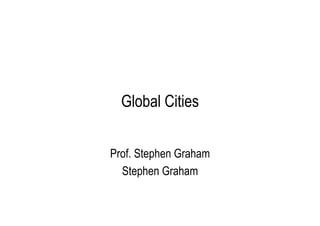
Global cities
- 1. Global Cities Prof. Stephen Graham Stephen Graham
- 2. Signs of an Urban Renaissance of Certain Cities Through New Technology and the ‘New Global Economy’
- 3. Local Examples: Newcastle Technopolis
- 4. “Silicon Alley” Televillage (Pink Lane)
- 5. “Sunderland “Teleport” Doxford Park
- 6. A Paradox: Globalization Processes, and the Use of New Transport and Digital Technologies, are Leading to a Patchy ‘Urban Renaissance’ of Certain Cities and Districts of Cities • Paradox: distancetranscendence, ‘space-time compression’ leading to a growing salience of urban place in economic location • Cities linked into global network of cities but on very different terms
- 7. Cities Embedded in Stark Global Divisions of Labour: Two Broad Positions -- “Sticky Places” versus “Slippery Spaces” • Stark geographical divisions of labour linking urban sites intimately across the world • Global network of cities • New technologies of communications and transport used to refine such divisions, not overcome them • Geographer Ann Markusen defines “Sticky Places” (high-value added, ‘creative’ and central locations) and “Slippery Space” (peripheral locations where routinised work and labour are located)
- 8. First, Markusen’s “Sticky Places” • High value-added and creative locations within or near core, ‘global’ cities • Excellent transport and telecoms connectivity provided by market and infrastructure advantages
- 9. • ‘Sticky place’ cities minimise risks to major finance, legal, headquarter and media/high tech companies through cutting-edge skills and highly diverse labour markets • ‘Soft’ social and cultural services and ‘cool’ urban ambience • Sustain and support continuous innovation and research and development through intense face to face and online contact
- 10. Loughborough University’s Inventory of World Cities
- 11. ‘Alpha’ world cities like London • • • • • • • • • • • Global stock exchanges Banking and corporate headquarters Fashion Media, film, TV Fashion Non government organisations International organisations/ governments Huge centres of symbolic property development, infrastructural investments, main hubs of global airline, port, rail, telecommunications systems Destinations of international migration Locations for international events, sporting events and conferences Increasing sense of England being two nations
- 13. Revitalised Urban Cores: Highly Localised Geographies of ‘Dot.Com’ Activity • Self sustaining cycles of innovation, speculation, venture capital, investment, migration create boom cities • Competitive advantage overcomes high costs • Gentrification and “cappuccino urbanism” leads to social exclusion • New York case study in video next session
- 14. New York’s “Silicon Alley”
- 15. ‘Technopoles’ on Peripheries of Global Cities • Main high-tech and corporate research and development centres • Campus style, suburban environments • Relate very closely with major technology universities • Highly dualised labour markets: well rewarded technological elites and often invisible support workers
- 16. Silicon Valley is Archetype • But technopole spaces actually develop organically through intense research and development by entrepreneurs and small firms • Can boost dynamics once underway • But very difficult to engineer or create through planning and public policy alone, especially in peripheral locations
- 17. UK “Knowledge Corridor” - Oxford-Cambridge
- 18. Second, and in contrast, “Slippery Space” Cities Global peripheries in global N and S: Areas of low skills/wealth and/or high un- and under employment • Ruthless cost-based competition for globalizing, routine activities *
- 19. • Call centres, logistics hubs, free trade zones for manufacturing and assembly • Supported through: tax breaks, grants, free land, property and infrastructure • Such investments often intensely mobile. Often not selfsustaining, fragile. and require continuous subsidy
- 20. Data Processing, ‘Back Offices’ and Call Centre Parks • Global North and South competing with each other • Global “off-shoring” going on as mobile call centre investment moves from low cost regions in global north to rapidly growing high-tech cities in India, caribbean, Africa e.g. Bangalore (top), which are moving up the value-added chain
- 21. • Global South ‘technopole’ cities have highly fragmented structures: export processing and high technology zones with excellent infrastructural connections elsewhere separated off from surrounding informal or shanty settlements (which are often demolished and starved of investment and infrastructure) • (Right: Bangalore, India)
- 22. Must Remember, Most Global Cities in South are neither ‘Sticky Places’ Nor ‘Slippery Spaces” These are ‘Ordinary’ Cities ‘Off the Map’ • Many large and fast-growing urban areas (especially in global south) do not seem to have strong role within formal, globalised, spatial division of labour at all • Subsistence and informal economies and settlements and local markets • Even many parts of cities with role in globalised economy operate in the same ways • Majority urban world: Must look beyond glitzy, iconic ‘global’ sites! Next: Chungking, China
- 24. But Even Here, Hidden, ‘Global’ Economic Activities Exist • Resource extraction, mining, forestry, waste recycling • E.g. ‘E-Waste’ cities around Guandong, China • Where your VCR, mobile, PCs, TVs etc. end up!
- 25. Conclusions • Cities are placed in very different positions in global economy • Embedded in stark geographical divisions of wealth, power, technology and labour • New technologies used to exploit those divisions, not overcome them • Power and wealth centre on the ‘sticky places’ which orchestrate and organise global capitalism: ‘alpha’ and ‘beta’ ‘global cities’ • A second tier of cities has to fight to become ‘slippery space’ by inducing in routine, low value-added and fragile investments • Many of world’s ‘ordinary’ cities can attain neither status
- 26. We should remember that divisions of wealth, power and technology in a globalizing world are played out within as well as between cities And that these tend to be exacerbated by globalization trends
- 27. Next Session Video Case Study: The ‘Dot.Com’ Boom in the Pre-eminent ‘Sticky Place’ and ‘Alpha World City’ New York City 3 Questions • How has New York’s position as a high-tech global city and ‘sticky place’ effected the social divisions within the city • What have been the roles of new technology in the city’s renaissance and social conflicts over this process? • How have the processes of change depicted shaped the geographies of Manhattan?
